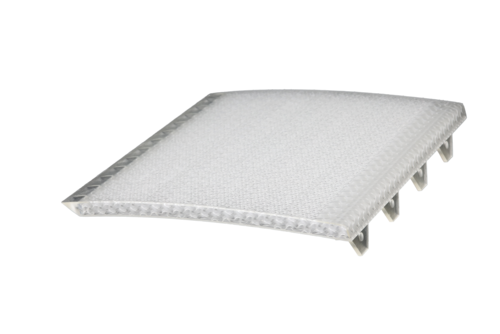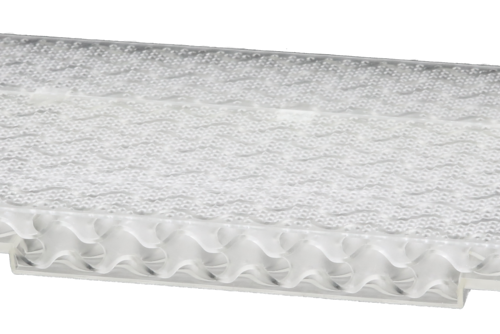
Laminarisation of aircraft wings reduces their friction drag and thereby increases the aircraft’s energy-efficiency. To achieve laminarity, extended hybrid laminar flow control (xHLFC) concepts are investigated that integrate active boundary layer suction at the rear section of the wing. If applied properly, the active suction of air from the boundary layer delays laminar-turbulent transitioning. This leads to a higher percentage of laminar flow on the surface of the wing and therefore to reduced friction drag.
Project B3.2 investigates an additive xHLFC suction panel concept that unites multiple functions in one integral part. By means of additive manufacturing a panel is designed that consists of a micro-perforated skin as aerodynamic surface, a core structure that provides structural support and transport of the suction air and connector solutions for transporting loads and suction air. Triply periodic minimal surface (TPMS) sheet networks are used to create the core structure as they allow lightweight construction, transport of air in every direction and adaptability of pressure distributions inside the core. Based on works from the prior project phase, first complete and working test panels will be designed and tested in wind tunnel campaigns.
Additive manufacturing promises to create complex integral structures with minimal effort. That is why this approach is chosen in this project for manufacturing of xHLFC suction panels with their dense but porous support structure. Especially stereolithography (SLA) and selective laser sintering (SLS) are investigated in this project due to their precision which is important in creating aerodynamic effective surfaces. Challenges are the perforations of the suction skin and connection solutions for panel sections, which are addressed in this project.

In the first project phase, TPMS structures have shown promising properties for use as a suction panel core structure. They allow mass transport in every direction through their channel-like design, which enables the transport of the air that is sucked in. In addition, they create a stiff but also lightweight support for the suction skin that can deal with the mechanical loads applied to the panel. First results show that they have equal mechanical properties as Honeycombs in terms of area moment of inertia when used as core in sandwich like structures.
Another important reason for the use of TPMS structures is their adaptability. As shown in the first project phase, the parameters of the TPMS structure can be variable in different directions to selectively adjust pressure losses inside the core structure. This is known under the expression functional grading and allows to fit a specific pressure distribution to the suction surface. Thereby it is possible to passively control the suction rate continuously over the perforated surface without pressure steps resulting from a chamber design as used in different approaches.

A main challenge in additive manufacturing of suction panels is printing the perforations in the suction skins. Generally, one aims at as many holes as possible which are as small as possible to come close to a continuously porous skin. However, the printing process limits the minimal hole size by printing parameters like the layer height and laser spot size.
This challenge is addressed by specific hole geometries that allow to print as small perforations as possible by avoiding significant overhangs while allowing removal of residual material. In addition, special post-processing steps are developed to remove such residual printing material. These approaches shall extend the limit of printable minimal hole sizes for effective suction skin design.
To evaluate partial solutions and the overall panel design, extensive test and measurement campaigns are planned. To model pressure losses and flow behaviour correctly, aerodynamic characterization of printed suction skin specimens and TPMS structures has to be conducted, for example measurements of pressure losses or impedance. In addition, the mechanical properties of the suction panels are important. Especially bending of the structure is investigated as wing bending will be a major effect in future applications. This can lead to a change in hole geometry and even hole blockage, which has to be prevented by means of an adequate hole design.
Special attention shall be given to wind tunnel campaigns. With the results from the first project phase in mind, all aspects shall be brought together into complete and functional suction panels that can show the suction behaviour under realistic flow conditions. With this, the benefits of additive xHLFC suction panels can be evaluated and valuable data for design of future panel designs can be collected.
Institute of Mechanics and Adaptronics
TU Braunschweig
Langer Kamp 6
38106 Braunschweig
Germany